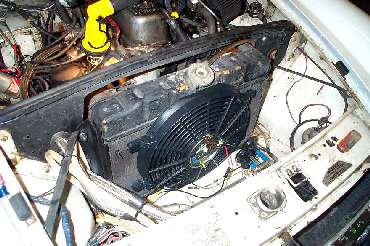Just a Simple Wrench
by Ann & Jake Snyder

Hot is Good
Most MG owners drive principally in the summer months. Some of those really drive only during the cooler parts of the summer months, as the air conditioning to which they are accustomed is not adequately replaced by unzipping the rear window (tourers) or opening the rear quarter lights (GTs). But for the truly hardy, one constant concern is overheating the engine, for whatever reason that may occur. In our experience overheating has always been traced to a cracked head, faulty head gaskets (once due to deferred retorquing of the head nuts until some of the nuts were little more than finger tight), or a leaking water pump. There are a host of other causes, but these have been our particular set of troubles, at least for summer driving.
We have added the particular challenges of using an MGB as a winter driver as well. This includes days when the winter temperatures typically are between freezing (the warmer extreme) and the temperature inside a freezer (as in "freezes raw chicken parts instantly"). The most difficult time to endure while driving is between when the engine catches on full choke and when the choke can be returned home. This is the time that the engine requires a lot more fuel due to poor vaporization in the cold intake manifold and head. And much of the extra fuel that full choke gives the engine is not even burned - it makes its way into the oil pan after washing down the cylinder bores and removing the lubricating oil. Once in the oil sump, the fuel dilutes the lubricating ability of the motor oil, and accelerates bearing and valve train wear. One more effect of cold-running is that the combustion chambers and pistons may not reach a temperature at which the rings seat well enough to bed in properly, which gives a better space for fuel to reach the oil sump and for oil to be burned in the combustion process.
Getting the engine warm as soon as possible is vital. Covering the oil cooler is a requirement, and using a thermostat in the oil line helps considerably. Covering half the radiator with cardboard helps, but more coverage may be required on really cold days and less on a day when the temperature goes above freezing. It is inconvenient to carry different sizes of cardboard, and it is inconvenient to refill the radiator after the coolant has boiled out. Covering the entire grill opening helps on warmer winter days, but the cardboard front end compromises the special attraction of the MGB styling. Covering the entire grill area from inside the grill looks a lot better, but is still not enough on a really cold day. After careful thought on the matter, we concluded that we have never had an MGB that ran at normal temperature in the dead of winter. In fact, the engine temperature frequently decreases with increasing speed, also decreasing the tiny wisp of warm air that keeps the inside temperature of the car barely tolerable, but never comfortable. Thus, our winter speeds are never quite as spirited on long trips as the same would be in spring or fall.
One recent winter day, while tuning an MGB in our garage, which is heated to the same level of effectiveness as are our MGBs, we noted the high probability of frostbite if working in the backwash of the fan. As the engine was not at normal operating temperature, and would probably not reach normal operating temperature that day, we reasoned that eliminating the fan's unnecessary activity when the engine was still cold might do wonders for the car and us. We put a new 95 ° C thermostat in the engine, but we have done this many times over the years, and never got a satisfactory engine temperature on the road.

The electric fan and its installation components
We consulted with club resources and were informed that the fan we needed was a Hayden 3680 and 3647 controller. The fan is a 12 inch diameter blade with a rated current draw of eight amps and is suitable as the primary cooling fan. Preferably, the fan should be mounted on the engine side of the radiator as a "puller", as this gives a 20 percent increase in air flow over using the fan on the grill side of the radiator as a "pusher" fan. In either case, the air flow must be directed toward the engine, and the polarity of the connection to the fan motor must result in proper air flow direction. We always appreciate advice, and sent an e-mail to Hayden asking how to buy one. The response was "Autozone, NAPA or PepBoys". However, the fan we wanted was not in stock, and we settled on an on-line order to Nothern Auto Parts for a Perma-Cool fan 12 inches in diameter (P/N 19122) and an adjustable controller (P/N 18905).
There was not enough space between the radiator and the water pump pulley to mount the fan in the "puller" position, so we used the alternate position with the reasoning that the original fan could be refitted to the water pump pulley if the electric fan would not do the job in summer. We followed the instructions that came with the parts, although inserting the long mounting tabs and the controller probe into the radiator core was troubling. But nothing broke and nothing leaked.  We connected power to the controller though a regular 12 volt auto relay. We wanted the fan to run only when we were in the car with the ignition switched "on", though a walk through a parking lot on a hot day frequently reveals a chorus of fans that are happily running unattended. Our argument is that the mechanical fan on the water pump pulley stops when the engine stops, so the electric fan should, as well. We elected to use a relay rather than simply tapping into the white wire at the fuse block to keep from overloading the contacts in the ignition switch, remembering that the relay cost five dollars, but that ignition switches commonly run about a hundred dollars.
We connected power to the controller though a regular 12 volt auto relay. We wanted the fan to run only when we were in the car with the ignition switched "on", though a walk through a parking lot on a hot day frequently reveals a chorus of fans that are happily running unattended. Our argument is that the mechanical fan on the water pump pulley stops when the engine stops, so the electric fan should, as well. We elected to use a relay rather than simply tapping into the white wire at the fuse block to keep from overloading the contacts in the ignition switch, remembering that the relay cost five dollars, but that ignition switches commonly run about a hundred dollars.
The instructions for connecting the relay refer to the diagram and terminal numbers that are printed on every 12 volt 15 amp auto relay: The "colors" on the MG fuse block are from the standard arrangement as illustrated in many manuals.
 a. Connect a white wire from the fuse block white terminal to relay terminal 85.
a. Connect a white wire from the fuse block white terminal to relay terminal 85.
 b. Connect relay terminal 86 to ground (bare metal, no paint).
b. Connect relay terminal 86 to ground (bare metal, no paint).
 c. Connect a brown wire from the fuse block brown terminal to relay terminal 30.
c. Connect a brown wire from the fuse block brown terminal to relay terminal 30.
 d. Connect relay terminal 87 to the fan controller power line fuse.
d. Connect relay terminal 87 to the fan controller power line fuse.
We followed the rest of the instructions for connecting the fan and controller. In all, we had only one little problem that surfaced later: One of the 0.062 inch Molex connectors in the female plug of the controller broke off. Ultimately, we bought a package of P/N 1561-60 Molex pins from BA-Electronics.com (Rte 1 Box 100, Bunch, OK 74931, Phone 918-696-5998, Fax 918-696-5999). The pins cost three dollars for 10 sets, and we spent an extra ten dollars for sanity insurance in the form of a Molex pin extracting tool. In order to minimize more Molex pin repairs, we added a bracket to which the controller connector could be secured from unnecessary vibration.

The electric fan installed in the MGB





